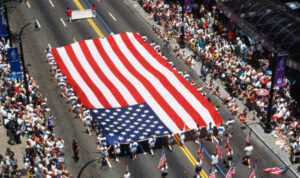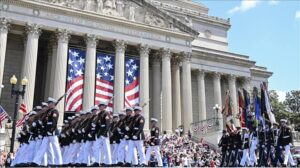Explore the history, traditions, and contemporary significance of the Fourth of July in the United States. Discover how Independence Day celebrates the spirit of freedom and patriotism through fireworks, parades, barbecues, and more.
Introduction
The Fourth of July, also known as Independence Day, is one of the most significant holidays in the United States. It commemorates the adoption of the Declaration of Independence on July 4, 1776, when the thirteen American colonies declared their independence from British rule. This historic day is celebrated with a variety of traditions and festivities, reflecting the spirit of freedom and patriotism that defines the nation.

Historical Background
The road to American independence was paved with conflict and a desire for self-governance. By the mid-18th century, the thirteen American colonies were growing increasingly discontented with British rule, particularly with policies such as taxation without representation. Tensions culminated in events like the Boston Tea Party in 1773, where colonists protested against the Tea Act by dumping British tea into Boston Harbor.
In 1774, the First Continental Congress convened to address these grievances, but it was the Second Continental Congress, beginning in 1775, that played a crucial role in the push for independence. The tipping point came on June 7, 1776, when Richard Henry Lee of Virginia introduced a resolution calling for independence. After much debate, the resolution was adopted, and a committee including Thomas Jefferson, John Adams, Benjamin Franklin, Roger Sherman, and Robert Livingston was tasked with drafting the Declaration of Independence.
Thomas Jefferson, known for his eloquent writing, penned the initial draft, which was then edited and approved by the Continental Congress. On July 4, 1776, the Declaration of Independence was formally adopted, marking the birth of a new nation dedicated to the principles of liberty, equality, and self-determination.
The Declaration of Independence
The Declaration of Independence is a seminal document that articulates the philosophical foundations of American democracy. It begins with a preamble that outlines the inherent rights of individuals and the justifications for rebellion against tyranny:
> “We hold these truths to be self-evident, that all men are created equal, that they are endowed by their Creator with certain unalienable Rights, that among these are Life, Liberty and the pursuit of Happiness.”
The document then enumerates the grievances against King George III, illustrating the colonists’ reasons for seeking independence. It concludes with a resolute assertion of the colonies’ status as free and independent states, absolved of all allegiance to the British Crown.
Early Celebrations
The first celebrations of American independence were marked by public readings of the Declaration, parades, and gatherings. In Philadelphia, where the Declaration was signed, the Liberty Bell was rung to mark the occasion. This tradition of public celebration continued in subsequent years, with towns and cities across the new nation hosting their own festivities.
John Adams, one of the signers of the Declaration, predicted in a letter to his wife Abigail that July 4th would be celebrated by future generations as a great anniversary festival, marked by pomp and parade, shows, games, sports, guns, bells, bonfires, and illuminations. His vision has largely come to pass, as these elements remain central to modern Fourth of July celebrations.

Traditions and Festivities
Over the years, Independence Day has evolved into a day of diverse celebrations that bring together Americans of all backgrounds. Here are some of the most common traditions and festivities associated with the Fourth of July:
1. Fireworks:
Fireworks are perhaps the most iconic aspect of Independence Day celebrations. Cities and towns across the country host spectacular fireworks displays that light up the night sky in a burst of colors. Major cities like New York, Washington D.C., and Boston are known for their grand fireworks shows, often accompanied by patriotic music.
2. Parades:
Parades are a staple of Fourth of July celebrations, featuring marching bands, floats, military units, and community groups. These parades reflect the local culture and history, bringing communities together in a spirit of unity and patriotism.
3. Barbecues and Picnics:
Food plays a central role in Independence Day festivities, with families and friends gathering for barbecues and picnics. Traditional foods include hamburgers, hot dogs, corn on the cob, and various salads. It’s a time for communal feasting and enjoying the summer weather.
4. Patriotic Music:
Music is an integral part of the celebrations, with patriotic songs like “The Star-Spangled Banner,” “America the Beautiful,” and “God Bless America” being played and sung at various events. Concerts and musical performances are often held in parks and public spaces.
5. Sporting Events:
Many Americans celebrate the Fourth of July by attending or participating in sporting events. Baseball, known as America’s pastime, often features prominently, with Major League Baseball games being a popular activity on this day.
6. Community Events:
Local communities host a variety of events, including fairs, carnivals, and historical reenactments. These events provide opportunities for people to learn about American history, engage in family-friendly activities, and foster a sense of community spirit.
Symbolism and Patriotism
Independence Day is a time when symbols of American patriotism are prominently displayed. The American flag, with its stars and stripes, is ubiquitous, adorning homes, buildings, and public spaces. Red, white, and blue decorations are used to create a festive atmosphere, and many people wear clothing in these colors to show their national pride.
Patriotism is expressed in various forms, from the recitation of the Pledge of Allegiance to speeches and ceremonies that honor the nation’s founders and military personnel. It’s a day for reflecting on the values and principles that underpin American democracy, as well as the sacrifices made by those who fought for and defended the country’s independence.
Contemporary Significance
While the Fourth of July is rooted in historical events, its significance continues to evolve in contemporary America. It serves as a reminder of the nation’s journey towards freedom and the ongoing efforts to uphold the ideals of liberty and justice for all.
In recent years, the holiday has also become a time for reflecting on the complexities of American history and the challenges that remain. Discussions about social justice, equality, and the rights of marginalized communities are part of the broader narrative of what it means to be truly independent and free.

Conclusion
The Fourth of July is more than just a day of celebration; it is a profound expression of the American spirit. It encapsulates the nation’s history, its enduring values, and the collective aspiration for a future where freedom and equality are accessible to all. As fireworks light up the sky and families gather to celebrate, Independence Day stands as a testament to the resilience and unity of the American people. Whether through parades, music, food, or reflection, the Fourth of July remains a day of pride, remembrance, and hope for the United States.
Disclaimer
The information provided in this blog is for general informational purposes only. While efforts have been made to ensure the accuracy and reliability of the content, the author makes no representations or warranties of any kind, express or implied, about the completeness, accuracy, reliability, suitability, or availability with respect to the blog or the information contained within it. Any reliance you place on such information is therefore strictly at your own risk. The views and opinions expressed in this blog are those of the author and do not necessarily reflect the official policy or position of any agency or organization.




